Learning the James In
The School of Hard Rocks
By Nancy Wright Beasley, Contributing Writer
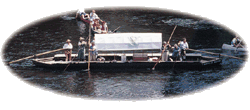 Even though my
teeth were already chattering from the cold, I felt a deeper chill when Judy Morrill, who
had been working the front sweep of the batteau most of that Sunday in June, turned and
asked, "Nancy, do you know how to go down rapids?" To my negative reply, she
said, "Always remember to put your feet first. You may break a leg, but you’ll
save your head." Even though my
teeth were already chattering from the cold, I felt a deeper chill when Judy Morrill, who
had been working the front sweep of the batteau most of that Sunday in June, turned and
asked, "Nancy, do you know how to go down rapids?" To my negative reply, she
said, "Always remember to put your feet first. You may break a leg, but you’ll
save your head."
Breaking bones in rushing rapids was not what I had expected from the James River
Batteau Festival. But in retrospect, I’d have to say that ignorance was my companion
when I signed on in February 1999 as a member of the Lady’s Slipper crew. Why
do it? I was intrigued by the all-female group, which is primarily made up of professional
women over the age of 50. I wanted to see what inspired them to attempt a task that always
proved difficult, even for robust men.
I was looking forward to the adventure and wanted to experience the serenity they
described of floating in inner tubes. Most of all, I wanted to learn what bonded these
women and motivated them to take on such a challenge.
However, my warm-and-fuzzy expectations of life on the river ran headlong into the
awesome force of Mother Nature.
 Ralph Smith, director
of the festival for the first time in 1999, says, "I’ve been involved with the
James River Batteau Festival for 14 years. It just doesn’t get any worse than what
the Lady’s Slipper faced last June." Ralph Smith, director
of the festival for the first time in 1999, says, "I’ve been involved with the
James River Batteau Festival for 14 years. It just doesn’t get any worse than what
the Lady’s Slipper faced last June."
About 30 miles downstream from Lynchburg, where the Slipper had left a cheering
crowd and serenely entered the James River at Percival’s Island, the 4,500-pound boat
jumped a cluster of rocks and broadsided a boulder on the second of a planned eight-day
trip in the water.
With torrents ripping around their waists, four of the seven women on board and a
visiting free-lance photographer, the lone man, slid cautiously into the rapids at Wreck
Island, so named because several boats had cracked like eggs against the rocks in past
years.
Barely hanging on, they fought to gain footing on algae-covered rocks, while water
churned in whitecaps, sucking their feet out from under them, thwarting their ability to
stand erect. Minutes seemed like hours. The boat wouldn’t budge. Exhausted, the five
crew members were pulled back to safety by the remaining three and watched as a
triangle-shaped orange distress flag was tied to a pole and hoisted into the air.
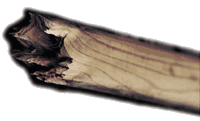 Smith, captain of the
Anthony Rucker of Amherst County, and his crew had volunteered to run backup for
the Lady’s Slipper. Although the Rucker crew had provided assistance
several times the day before when the Slipper had experienced problems, the
appearance of the orange flag signaled a crisis. Smith, captain of the
Anthony Rucker of Amherst County, and his crew had volunteered to run backup for
the Lady’s Slipper. Although the Rucker crew had provided assistance
several times the day before when the Slipper had experienced problems, the
appearance of the orange flag signaled a crisis.
"When I saw where they were, all I could think about was we’d gone 14 years
without a fatality, but that might change," Smith explains. "The way I figured,
we only had two choices — either someone was going to get sucked under that boat and
crushed between it and the rocks or the boat was going to split in half." While one
man stayed with the Rucker, four others entered the swirling water in an attempt to
free the Lady’s Slipper.
A Celebration of River Life
The eight-day festival is a celebration of life on the river and former times when men,
primarily slaves, moved various products down river in the earliest development of
commercial trade on the James.
Fashioned after the American Indian dugout, the first batteaux, dating
back to 1749, proved crucial for commercial development and were used to move agricultural
products down river. The practice blossomed until some 500 batteaux plied the waters of
the James River, delivering a myriad of products from tobacco to apple brandy to hungry
markets down river.The skill of the crews became legendary as they maneuvered through
treacherous waters known to splinter batteaux against "sleepers," rocks that
aren’t visible until they scrape the bottoms of the unwieldy boats. The batteaux are
guided fore and aft by large paddles called "sweepers" and propelled by crew
members walking on sideboards, wielding poles measuring 15 feet or longer.
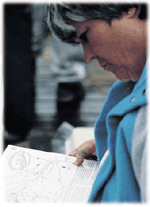
Ginnny Morton
|
Spanning 120 miles of the James River and 10 counties, the festival
rolls out like a blanket along the shoreline. Community groups gather to feed the various
crews at seven different campsites before the batteaux complete the event at Maiden’s
Landing in Powhatan County, 27 miles from Richmond.
Historically, no women worked on the batteaux. And, although there are women on some of
today’s batteaux, the Lady’s Slipper has, thus far, claimed the
distinction of being the only all-female crew to maintain and manage one. Although there
are a few younger members, the 1999 crew ranged in age from 45 to 60.
In previous years, as many as 20 other batteaux have participated in the
festival. Only 11 batteaux participated in the festival last year. Four, including the Lady’s
Slipper, pulled out before the end of it."We had several things going against
us," explains Smith. "The water level was the lowest the river had been in 25
years. And there was a head wind that just wouldn’t quit."
The Lady’s Slipper had been wintered at Grayhaven Winery in Gum Spring, the
home of Chuck and Lyn Peple. Since I wanted to experience every phase of the trip
personally, I volunteered when it came time to refurbish the rugged boat for the 1999
festival.
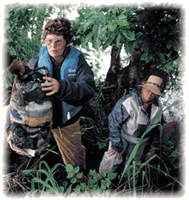
Betty Newland (I) & Judy Mornill
|
After the batteau was emptied of layers of rock salt and oak leaves,
used as preservatives, several days of brute work followed. The walking boards, where crew
members step in unison to guide the batteau with poles, had to be planed; rusty screws
needed replacing; and finishing touches were needed on the canopy, a unique apparatus
designed and sewn by Margaret Gerdts which gave the batteau the look of a covered wagon.
On the opening day of the festival, the Lady’s
Slipper joined the fleet of departing batteaux headed down the James River to
Maiden’s Landing. The trip downstream was grueling. Even so, the beauty of the trip
did not go unnoticed as the women paused occasionally to identify trees or confuse birds
by mimicking mating whistles.At dusk, two members of the Rucker crew boarded the
Lady’s Slipper in an effort to expedite her arrival at Christian’s Creek,
the first campsite on the trip. We were averaging about a half-mile an hour.
Night came so fast it went almost unnoticed as the polers continued to guide the boat
down river. Without warning, the Rucker went broadside behind the Slipper in
a "T-Bone" formation, causing the forward sweep of the Rucker to sit atop
the stern of the Slipper.
| Note: Cannon’s Wrecks, at
Wreck Island – "A fall of 5 feet in something less than 300 yds., which was
extremely difficult to ascend with five hands, our load and cover to the boat (about 3,000
lbs.) the whole of the river is here confined to a very narrow space and of course deep
enough, and the pass being tolerably straight the danger is not great in descending, but
in ascending, it requires great dexterity to keep the boat parallel with the current, for
if it happens to vary so as to thwart the current in any considerable degree the strength
of men and poles are not adequate to prevent its getting across the breakers which
immediately destroys the strongest Boats; and in this way may have been wrecked & much
valuable property lost." (1818 quote taken from Thomas Moore’s James river
survey in a low water period in August 1818.) Credit: A History of the Navigation of the
Upper James, copyright 1985, by the Virginia Canals and Navigations Society. |
After the two batteaux were separated, a decision was made to lash them
to trees and walk the last mile to camp. A human chain was formed and crewmembers went
hand in hand through waist deep water, ultimately climbing a muddy bank covered in poison
ivy at an angle steep enough to challenge any billy goat. When we finally arrived, it was
11:30 p.m. — twelve and a half hours after our departure; we had managed to cover
only 18 of the first day’s scheduled 19 miles.
The following morning, we left camp in a pouring rain. Ginny Morton, who had been
having difficulty with her back the day before, didn’t hesitate to join the crew.
When I asked her why she was willing to endure pain and stick out what would surely prove
to be another very difficult day, she quietly said, "It’s about
commitment."
The second day, which was as trying as the first, became marred with the near-disaster
at Wreck Island. When we were finally free, the Lady’s Slipper dropped anchor,
giving our beleaguered crew the first real break during the two-day ordeal.
After recovering from Wreck Island, we headed downstream again. Judy took over the
sweep as we approached turbulent water again. Betty Newland and I stood just behind her
using poles. The stern of the boat suddenly swerved as Judy used all her strength to try
and guide the unwieldy craft.
An eerie feeling crept up my back as I watched the muscles in Judy’s neck and arms
strain against the rapids. Suddenly, there was a splintering sound, and four feet of the
sweep, including the paddle, broke off and cannon-balled toward Judy, Betty and myself,
landing within inches of our feet.
Now limited to only a back sweep, the crew poled to a site where we
walked the Lady’s Slipper to shore at Bent Creek. We secured the boat and
headed for James River State Park, where the crew decided that it would not be feasible to
continue in the festival because of the batteau’s condition, the exhausted crew and
the low level of water in the river. Wendy Wadsworth, a former Lady’s Slipper
captain, had arranged a trip from Costa Rica, where she now teaches, to coincide with the
batteau festival. Disappointed that she wouldn’t be able to go on the river, she
volunteered to accompany the crew to help dismantle the batteau.
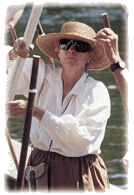
Margaret Gerdts
|
"She’s probably crying inside," co-captain Sidney Dodson
said quietly as she wiped away her own tears. "We wait all year for this. It’s a
disappointment to everybody. I mark this on my calendar on January 1 each year, and the
folks at the office know I better not get bumped from it."
A picnic, prepared earlier by the ground crew, was spread out on the batteau and
leisurely enjoyed, a quiet tribute to the end of the Lady’s Slipper sojourn.
After the meal, the breakdown went fast, almost hurried. The empty batteau was walked
further upriver and securely tied. She bobbed a bit in the water as if tipping her hat to
the dejected women as we waded to shore.
After a short rest at "Higher Ground," a beautiful, sprawling complex in
Buckingham County, the refreshed crew patched inner tubes and floated on our first
leisurely trip down river. The following days were spent much the same way.
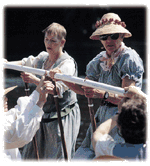
co-captain Sidney Dodson and captain Betsy Healey
|
Adelaide Lee and her husband, Mike, usually float along in a canoe with some of the
batteaux each year. When asked her opinion of the all-female crew, Adelaide grinned
broadly and said, "I just love the Lady’s Slipper. I’ve seen them
come dragging in during other festivals at 11 p.m., but they always manage to finish. The
men rag on them, but they are really very proud of them, too. You have to admire them.
Regardless of what happens, they just never give up."
Her statement summarized what I had come to accept during the venture. By living among
them, working alongside them, and actually being absorbed into the group, I began to feel
the bonds that hold these women together so tightly.
It was the beauty of the river seen from the reverse side of civilization. It was the
diversity of the group that ranges from college professors to an occupational therapist to
appliance repair technicians. It was the wild panorama of emotions that run the gamut from
fear of dying in the rapids to stopping in the road and gently moving turtles to a side
path.
It was the ability of the crew to overcome unbelievable adversity without
uttering one single curse word. It was the discipline needed to overcome individual
preferences and work together to meet a common goal. It was breaking the stereotype of
what a woman is, while also supporting it. It was exploring the range of physical and
emotional demands from deciding which path to take in the rapids to standing in a rope
swing and pumping it skyward with your knees like a child.And, it was knowing that
— even with the fear and the imminent struggle that will surely accompany it —
each will probably do it again next year.

Information about the James River Batteau Festival is available by writing:
P.O. Box 10564
Lynchburg, VA 24506
The Women’s Batteau Guild can be reached through Betsy Healey at (804)
375-9138 or by writing:
P.O. Box 31, 29 Church Street
Cartersville, VA 23027
This year’s festival will be held June 16-24. |